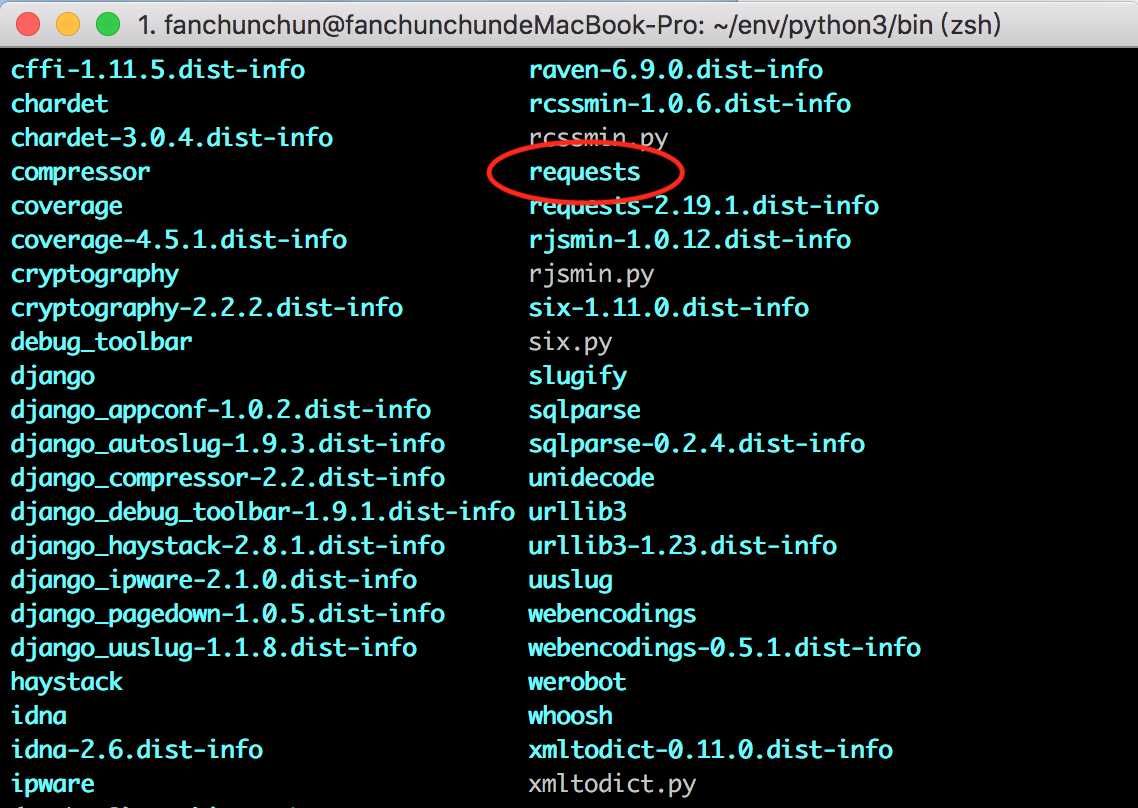标签:eval 文档 命令 pass 通用 set max jar 字节序
原文链接:https://www.fkomm.cn/article/2018/7/16/16.html
来说先说爬虫的原理:爬虫本质上是模拟人浏览信息的过程,只不过他通过计算机来达到快速抓取筛选信息的目的所以我们想要写一个爬虫,最基本的就是要将我们需要抓取信息的网页原原本本的抓取下来。这个时候就要用到请求库了。
requests库本质上就是模拟了我们用浏览器打开一个网页,发起请求是的动作。它能够迅速的把请求的html源文件保存到本地
安装的方式非常简单:
我们用PIP工具在命令行里进行安装
$ pip install requests
接着我们看一下是否成功安装了requests库:
$ pip list
看一下安装结果:

#首先我们先导入requests这个包
import requests
#我们来把百度的index页面的源码抓取到本地,并用r变量保存
#注意这里,网页前面的 http://一定要写出来,
#它并不能像真正的浏览器一样帮我们补全http协议
r = requests.get("http://www.baidu.com")
# 将下载到的内容打印一下:
print(r.text)可以看到,百度的首页源码文件我们已经把他抓取到本地了。

上面的抓取过程中,我们用到了requests库的get方法,这个方法是requests库中最常用的方法之一。
他接受一个参数(url)并返回一个HTTP response对象。
与get方法相同的,requests库还有许多其他常用方法:
#这个方法可以接收三个参数,其中第二个默认为None 第三个可选
def get(url, params=None, **kwargs)
#作用是模拟发起GET请求
Sends a GET request.
#模拟获取页面的url链接
:param url: URL for the new :class:Request object.
#额外参数 字典或字节流格式,可选
:param params: (optional) Dictionary or bytes to be sent in the query string for the :class:Request.
# 十二个控制访问参数,比如可以自定义header
:param **kwargs: Optional arguments that request takes.
# 返回一个Response对象
:return: :class:Response <Response> object
:type: requests.Response常用的两个控制访问参数:
hd = {‘User-agent‘:‘123‘}
r = requests.get(‘http://www.baidu.com‘, headers=hd)
print(r.request.headers)
‘‘‘
OUT:
{‘User-agent‘: ‘123‘, ‘Accept-Encoding‘: ‘gzip, deflate‘,
‘Accept‘: ‘*/*‘, ‘Connection‘: ‘keep-alive‘}
‘‘‘pxs = { ‘http‘: ‘http://user:pass@10.10.10.1:1234‘,
‘https‘: ‘https://10.10.10.1:4321‘ }
r = requests.get(‘http://www.baidu.com‘, proxies=pxs)‘‘‘
Response(self)
The :class:Response <Response> object, which contains a server‘s response to an HTTP request.
‘‘‘
#HTTP请求的返回状态,比如,200表示成功,404表示失败
print (r.status_code)
#HTTP请求中的headers
print (r.headers)
#从header中猜测的响应的内容编码方式
print (r.encoding)
#从内容中分析的编码方式(慢)
print (r.apparent_encoding)
#响应内容的二进制形式#print (r.content)
‘‘‘
status_code:200
headers:
{‘Server‘: ‘bfe/1.0.8.18‘, ‘Date‘: ‘Tue, 02 May 2017 12:01:47 GMT‘, ‘Content-Type‘: ‘text/html‘, ‘La
st-Modified‘: ‘Mon, 23 Jan 2017 13:28:27 GMT‘, ‘Transfer-Encoding‘: ‘chunked‘, ‘Connection‘: ‘Keep-A
live‘, ‘Cache-Control‘: ‘private, no-cache, no-store, proxy-revalidate, no-transform‘, ‘Pragma‘: ‘no
-cache‘, ‘Set-Cookie‘: ‘BDORZ=27315; max-age=86400; domain=.baidu.com; path=/‘, ‘Content-Encoding‘:
‘gzip‘}
encoding: ISO-8859-1
apparent_encoding:utf-8
‘‘‘import requests
def getHtmlText(url):
try:
r = requests.get(url, timeout=30)
# 如果状态码不是200 则应发HTTOError异常
r.raise_for_status()
# 设置正确的编码方式
r.encoding = r.apparent_encoding()
return r.text
except:
return "Something Wrong!"好了关于requests库我们今天就写到这,
这是一个非常强大的库,
更多的功能大家可以去看一下官方的文档
http://docs.python-requests.org/zh_CN/latest/user/quickstart.html
标签:eval 文档 命令 pass 通用 set max jar 字节序
原文地址:https://www.cnblogs.com/yfy-python/p/10133707.html